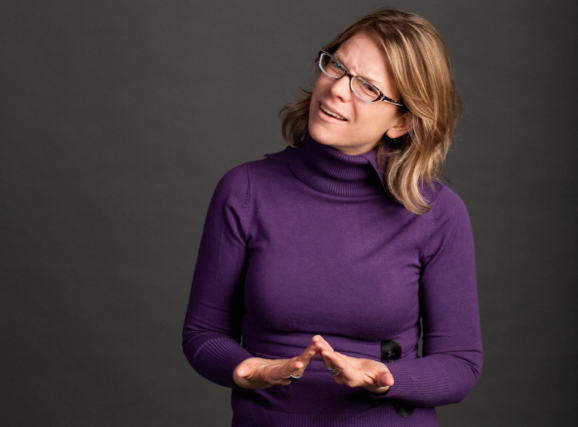
Professor Erin Wilkinson (Photo: Clara Haimes Kusumoto)
Canadian Language Museum: Language of the hands
Canadian Language Museum recently published a profile of U of M linguist Erin Wilkinson by Michael Iannozzi. Erin Wilkinson is an assistant professor in the department of linguistics, Faculty of Arts.
The article is excerpted below. To read it in full, visit the Canadian Language Museum website.
Language of the hands
Professor Erin Wilkinson is a linguist who studies signed languages, and who grew up speaking one of them. This subject is of such interest to me because it is so understudied and underrepresented in research, yet it responds to an essential need for humans : no matter the barriers, humans will find a way to communicate. Professor Wilkinson played the role of the Canadian Language Museum’s resident Mythbuster as she communicated clearly all the misconceptions, that so many of us — myself included, I am embarrassed to admit- – can fall subject to.
Michael Iannozzi: What led you to study linguistics?
Erin Wilkinson: This is the second most common question asked after “Is sign language universal?” To which the answer is no, signed languages are not universal. I often reply: Are spoken languages universal? Imagine people’s reaction.
My fascination with languages started when I was young. I was born to a hearing family who did not know how to sign, and we all were introduced to the Deaf world as we chose to learn American Sign Language (ASL). Books introduced me to English. I constantly asked my parents how and why did English worked in specific ways. It was a sure sign that I was a bona fide linguist as I was asking all these questions about rules of English compared to ASL.
MI: I think to a lot of people sign language will be thought of as English. I think there is a perception that it is just English in a signed form. How is it different?
EW: Yes, there are two assumptions about signed languages. The first assumption is that signed languages in general are not de facto languages [not true languages]. There are many documents that debunk this assumption; however, this assumption prevails among laymen and scholars.
The second assumption is that the signed language is a visual representation of their surrounding spoken language (however it would be more appropriate to say that it’s a visual representation of their surrounding written languages, as deaf people do not have access to spoken languages) [Meaning people often think that American sign language is just English using your hands instead of your mouth/pen].
Now, if we compare signed languages with spoken languages, then we must be cautious when we go down this road. There are many aspects of signed languages that are found in spoken languages (and vice versa); however, there appear to be modality-specific properties that only can happen in signed languages (visual-gestural) or spoken languages (oral-auditory) [Meaning that even though there are many similarities between a Signed Language and a spoken one, there are certain things that only occur in languages that are visual, and others that only occur in languages that are spoken]. It is important to understand that research on signed languages is far more sparse and is (relatively) young compared to the long history of spoken language linguistics. Second, we need to consider: what makes signed language communities? Deaf people are unique in terms of linguistic–cultural minorities. There is no evidence of a signed language community that can be classified as language majority, let alone a signed language as language majority in a community that has members who speak [meaning that users of a signed language make up the majority of a given community]. Sure, deaf people cannot hear English, but the Deaf people go to school, work, shop, text and go on the Internet. They clearly use written language to function in many situations, and it is not surprising to see characteristics of language contact (e.g. code switching or language mixing). Thus deaf people are bilingual by default.
MI: I think many people assume there is one sign language for all the English-speaking countries. How do the signed languages differ in the English-speaking world, and why?
EW: Yes, that is true as this is one of some common misconceptions that many people have. We don’t find that to be true. The classic example is signed languages used in the UK and the USA. Both the UK and USA are English-speaking countries, but they do not have an identical signed language “British accent” or “American accent”, but instead signed languages used are very different. The mutual intelligibility between British and American signers is low (similar to English speakers trying to understand Russian). Furthermore, Irish Sign Language is also different from both British and American signed languages.






